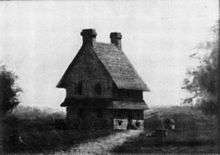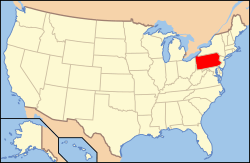William Brinton 1704 House
The William Brinton 1704 House is a historic house museum located 21 Oakland Road in Delaware County, Pennsylvania about five miles south of West Chester, Pennsylvania. Built in 1704, it is well-preserved example of an early Delaware Valley stone house, which served as a residence of one family for over 150 years. It was designated a National Historic Landmark in 1967.[2] It is open for tours on weekends between May and October, or by appointment.
William Brinton 1704 House | |
Brinton 1704 House in 2009 | |
  | |
| Location | Oakland Road, near junction of U.S. Route 202 and County Road 15199, near Dilworthtown, Pennsylvania |
|---|---|
| Coordinates | 39°53′47″N 75°33′40″W |
| Area | 3 acres (1.2 ha) |
| Built | 1704 |
| Architect | Unknown |
| NRHP reference No. | 67000018[1] |
| Significant dates | |
| Added to NRHP | December 24, 1967 |
| Designated NHL | December 24, 1967[2] |
History
The William Brinton 1704 House was built in 1704 by William Brinton, Jr. (also known as "William the Younger" or "William the Builder"). It was sold out of the family in 1860. In 1881, a serpentine stone wing was added to the home. In 1947 the house was purchased by Brinton descendants and donated to the West Chester Historical Society. In the 1950s, architect G. Edwin Brumbaugh restored the building to its original form by removing the 1881 wing and other Gothic embellishments.[3]

The William Brinton 1704 House was one of the 14 houses standing in the battlefield area of the Battle of Brandywine, fought on September 11, 1777 during the American Revolutionary War. In 1878, Thomas Eakins painted the Brinton House as it would have originally appeared.
Description
The Brinton House stands south of West Chester, on the east side of Oakland Road south of its junction with Brinton's Bridge Road. Its main block is a rectangular stone structure, built out of locally quarried stone laid in courses of irregular height. The walls are 22 inches (56 cm) thick and two stories in height. The end walls each have a brick chimney on the outside. There is a steep roof and pent eaves are in place over the first floor windows on the north and south sides of the house. The home also boasts 27 reproduction windows of leaded sash with diamond lights. Most of the original flooring is still in use.
The Dilworthtown Historic District is located about half a mile north of the house in Birmingham Township, Chester County, Pennsylvania.
See also
| Wikimedia Commons has media related to William Brinton 1704 House. |
References
- "National Register Information System". National Register of Historic Places. National Park Service. July 9, 2010.
- "Brinton, William, 1704 House". National Historic Landmark summary listing. National Park Service. Retrieved 2007-11-04.
- "NHL nomination for William Brinton 1704 House". National Park Service. Retrieved 2017-04-06.
External links
- The Brinton Association of America - House web site
- National Historic Landmarks Program
- Historic American Buildings Survey (HABS) No. PA-1258, "Brinton 1704 House, Oakland Road (Birmingham Township), Dilworthtown, Chester County, PA", 11 photos, 13 data pages, 1 photo caption page
- HABS No. PA-1258-A, "Brinton 1704 House, Privy, Oakland Road (Birmingham Township), Dilworthtown, Chester County, PA", 1 photo, 1 photo caption page
- Brandywine Valley: The Informed Traveler's Guide

